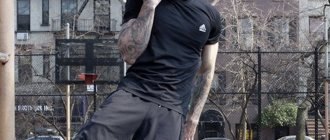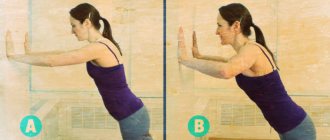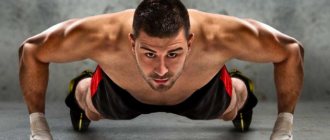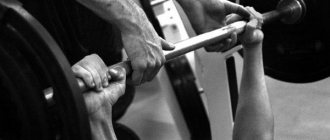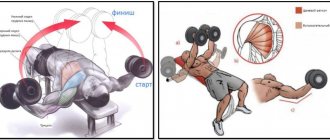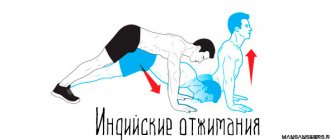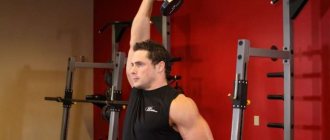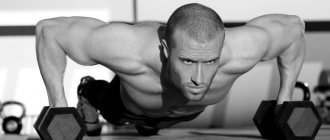Execution technique
Different trainers have their own techniques for doing push-ups with one arm. They are quite varied and suitable for athletes of varying levels of training. Some exercises are difficult to perform, but are more effective for pumping muscles. Other techniques are easier to perform, they are suitable for beginners, and their effectiveness will be lower.
In this version of the exercise, the body should be in the same position as with classic push-ups with some features:
- there will be three support points, instead of four, they should be placed in the form of a triangle;
- the working hand is placed under the body;
- the body from the heels to the crown should be straight;
- the shoulders are at the same level during the exercise and are parallel to the floor;
- feet stand shoulder width apart, as close as possible.
There are general requirements for push-ups with an emphasis on one hand, the basic technique for performing which is as follows:
- Starting position – the working hand is under the shoulder, closer to the middle of the chest, the legs are on their toes at a distance of shoulder width or slightly wider, the back is straight. The other hand can be placed with the palm on the buttocks or the back of the thigh.
- As you inhale, bend your working arm at the elbow, lowering your chest as low as possible. Ideally, at the lowest point the chest should be no higher than 10 cm from the floor. When lowering and ascending, bending at the lower back or “walking” with your shoulders is prohibited.
- Straining the muscles of your arms, push yourself to the starting position. Exhalation.
No one succeeds in lowering themselves “with their chest touching the floor” the first time. First you need to start lowering a few centimeters and not fall. You need to gradually lower the level of your “bottom point” until your chest is 10 cm from the floor.
It will be much easier to maintain balance if the pelvis is shifted towards the working hand, and the shoulder of the free hand is raised. This option is suitable for beginners in push-ups. Getting used to this method of training will not give good results, and such a technique will not be counted in competitions.
Push-ups for the pectoral muscles
Push-ups are a basic exercise for working the pectoral muscles. In addition to the chest, triceps and anterior deltoids are actively involved in the work. And if you perform a lot of repetitions, the back muscles are actively involved in the work.
There are quite a few options for push-ups for beginners:
- Classic.
- With legs on support.
- With hands on support.
At the same time, you can perform this exercise with both wide and close placement of your hands. In the first version you pump up the chest, and in the second - the triceps.
Technique for performing push-ups:
- Take a lying position. Place your hands slightly wider than your shoulders.
- Keep your back straight, do not lift your buttocks. Your body should describe a straight line.
- Look forward, don't lower your head down.
- Lower yourself smoothly, but do not touch the floor with your chest.
- At the bottom point, hold for 2-3 seconds to feel the tension in your pectoral muscles.
- Rise up with a powerful movement.
- At the top point, tighten your pectoral muscles. Don't stay long.
Now you might be wondering, is it worth fully extending your arms at the top? It depends on what muscles you want to train. If you only need to work the pectoral muscles, then you should not fully extend your arms. But if you don't mind the triceps getting tense, you can straighten your arms completely. However, this will result in you being able to do fewer reps per set. So, if you are working on the number of repetitions, you should not extend your arms completely.
Push-ups are completely identical to the bench press. After all, the target muscles in this exercise are the same as in the bench press. The corset muscles are also actively involved in the work, which will relieve you of back problems. The various push-up variations are also identical to incline presses.
For example, push-ups with legs supported are identical to bench presses with barbells or dumbbells at an upward angle. The main load in this exercise falls on the front deltoids and upper pectoral muscles. This version of the exercise is more difficult than the classic one.
Push-ups with hands on a support are easier to perform than classic push-ups. If your fitness level is fairly high, you can easily perform several dozen of these push-ups. The main load here falls on the lower part of the pectoral muscles. This option is suitable for beginners. And those who are already able to do more than 30 push-ups should replace this option with deep push-ups. For this you will need two chairs.
This version of push-ups is performed as follows:
- Place two chairs opposite the bed.
- Starting position - your feet are on the sofa and your hands are on the chairs.
- Your task is to perform classic push-ups.
- The difference here is that there is no floor underneath you and you can push up deeper.
A larger range of motion increases the effectiveness of your workouts. Deep push-ups are identical to dips. The main load falls on the middle and lower part of your pectoral muscles. Thus, after performing these push-ups, your chest will appear barrel-shaped.
These were simple push-up variations that were accessible to people of all fitness levels. In a few weeks of training, anyone can master all these variations and be able to do more than 30 push-ups per set. What should those who are already tired of doing push-ups do many times? To do this, there are more difficult options for performing this exercise.
Let's start with the fact that you can move your hands both forward and backward. That is, first you need to get into the starting position of classic push-ups. After this, move your hands 15-20 centimeters forward. Notice that it has become harder for you to stand. And it will also be harder for you to do push-ups. In classic push-ups, the upper chest is almost not involved. And this movement of the arms forward helps to awaken the “dormant” fibers in the area of the upper chest.
If you move your hands a little back, that is, closer to your waist, it will be very difficult for you to do push-ups. You're doing great if you can do at least 10-15 of these push-ups per set. They look like this:
With these push-ups, your front deltoids and triceps will be contracted from a completely different angle, and this will help you increase them. The main thing is to warm up well.
Once you can perform over 50 classic push-ups with perfect form in one set, you should try the one-arm push-up. This does not mean that the load will be twice as much as with classic push-ups. It will be much larger, because the stabilizers and lower back will not participate in holding the body, and the active arm will be additionally strained.
By doing push-ups on one arm , you will pump up all the pushing muscles very well. Such workouts will load you up no worse than the bench press. Therefore, if you are gaining weight at home, be sure to do push-ups on one arm.
Any variation of push-ups has a powerful anabolic effect on your body. What does it mean? The anabolic effect is the stimulation of muscle growth. It occurs when you perform basic exercises due to the fact that the whole body is under load. The same thing happens with push-ups, because in addition to the pushing muscle groups, the whole body is under static load. And this perfectly stimulates the growth of your muscles.
How to do push-ups correctly
You can do push-ups in different ways - all methods have different difficulty levels. Some of them are more difficult, others are simpler and easier for beginners.
The benefits of push-ups with clapWalking with Leslie Sansone: 2 mile complexSean T's workoutsWhich sneakers to choose for running: tips and rating
Reference method
The position of the body during execution is almost the same as during a classic push-up. The only difference is that you need to lean not on two, but on one palm, which is placed under the body. In other words, the body is like a straight line, the shoulders are parallel to the floor, and the legs are shoulder-width apart.
This is what one should ideally strive for, but it is unlikely that anyone will be able to immediately master it, even with impressive physical strength, for the reason that the ability to maintain balance and coordinate the work of various muscle groups is not enough.
Ideally, you should do push-ups like this . Take the starting position, i.e. lying down. Place one hand behind your back, with your hand at the level of your buttocks or slightly lower. We keep the body straight, legs touching only on toes, feet at shoulder level or slightly wider. As you inhale, the arm bends at the elbow, the chest drops almost to the ground. The lower back should be kept straight. When exhaling, you need to “push” yourself to the starting position.
The following simple techniques will help make the exercise easier. If you spread your legs wider, it will become easier to maintain balance, which will allow you to move your working arm further away from the middle level of the body. As a result, a lot of the load is transferred from the triceps to the pectoral muscles; bringing the pelvis to the working hand and slightly raising the opposite shoulder will make it easier to balance.
These techniques should only be used at the initial stage of training, when you are just mastering this technique. Otherwise, you can get used to this type of execution, which will prevent you from progressing further.
Due to its complexity, learning to do one-arm push-ups is not easy and requires constant practice. Therefore, it is worth starting with a number of preparatory exercises , with the help of which you can prepare your body for the required - standard push-up technique.
With partial support on the second hand
To perform this exercise, you will need some kind of support: a ball, a stool, or something else. The push-up will look like this: First, you need to take a lying position. The arm, which ideally is tucked behind the back, should be straightened and moved to the side, with the palm resting on the support.
You won't be able to fully lean on it, but it will give you partial support , which will make it easier to do, and you won't have to put it on the floor. When doing push-ups, concentrate on the strength of the muscles in your supporting arm.
This type of push-up is simpler than a full push-up, but more difficult than the classic push-up. Gradually try to transfer the weight of your entire body to the supporting hand, and lift the other away from the support.
On the back of the hand
You need to take a standard push-up position , place your palm on the floor, but place your other hand with your palm on the back.
With this approach, doing push-ups is quite difficult and uncomfortable, which is why you will involuntarily transfer most of the weight to the first one. To do this, you should: Take a position, as in a classic push-up, only with the palm of one hand turned to the back, and the body weight should be transferred to the other.
When doing push-ups, concentrate all your efforts on the one with your palm facing down.
Hands above feet
This exercise reduces the load on the supporting arm , making it easier for the muscles to get used to it. It works like this. The support is placed on a small hill. It can serve as a step, a bench or the edge of a bed.
This will reduce the strain on the muscles, allowing you to focus as much as possible on practicing your balancing. The body is straight, the second one is retracted behind the back, leaving a hollow space when bent. When it becomes easy for you to do push-ups in this position, the height of the support should be gradually reduced, gradually reaching the floor.
Execution on fingers
There is also a more complex version of the technique - push-ups with support on one finger .
Push-ups on one finger are possible, but they come to this gradually: starting, they do push-ups on four fingers, gradually reducing their number.
It must be remembered that the fingers are heavily loaded, so proper preparation and gradualness are very important here.
There is another interesting technique - push-ups without hands. Although these are more likely squats.
Kinds
It's difficult to do push-ups on one hand. It takes long training, a strong-willed character, and determination to overcome all difficulties and reach the intended goal. It is impossible to stand on three supports instead of four the first time. This goal must be achieved gradually. To make training easier, you can first use preparatory exercises – individually or in combination:
- Partial support on the second hand. For classes you will need an additional object, for example a ball. It fits under the second non-supporting arm, which is moved to the side, and not behind the back, as in a classic push-up. In this case, it does not touch the floor, but rests a little on the object. You need to concentrate on your supporting hand, trying to shift the entire load onto it.
- Supporting the second hand with the back side is push-ups from the floor, the position of the hands is different. Although both hands are involved, one of them rests on the floor with its back, creating a fulcrum, but you cannot fully lean on it, so almost the entire load is carried out on the second hand, which rests its palm on the floor.
- Putting your hands above your feet. The exercise involves doing push-ups on an elevated surface, such as a bench, sofa, bed, etc., at an angle.
- Negative when, when lowering the body, only the supporting hand works, and the second is used to lift it.
- Incomplete, in which an object is placed on the floor at chest level. You don’t need to go down so low, and the muscles of your working arm are less strained.
- With a jump. The action occurs in reverse order. Starting position – the arm is bent at the elbow, the body is tilted towards the floor. A sharp push up and a neat, slow return down.
- Support on one leg. A push-up uses only one arm and one leg, such as the left arm and right leg or vice versa. The second arm, like the leg, is placed wide to make it easier to balance.
There are other ways to make push-ups easier. They allow you to quickly master the technique, making training more fruitful and varied.
Benefits of one-arm push-ups
This exercise brings great benefits to the body. During work, the muscles of the arms and chest, shoulders and back are strengthened. You can do push-ups at any time of the day - it depends on your taste and free time
It is important to know that doing this in the morning is especially useful, as the muscles warm up perfectly and the body wakes up perfectly. This means that you will be fully prepared for the working day.
One-arm push-ups should be done several times to give your muscles a rest. One of them consists of ten repetitions. This will be enough to get started. Of course, over time you need to increase the load. The main thing is gradualism. If you can’t do any more push-ups, be sure to give your muscles a break.
Common mistakes
Sport is considered an activity where it is much easier and more useful to learn from other people’s mistakes, because violation of exercise technique often leads to injuries and sprains, and simply to a decrease in training productivity:
- incorrect positioning of the supporting arm relative to the body often leads to loss of balance;
- shifting the center of gravity due to the rise and descent of the pelvis. In the first case, the load from the target muscle group will go to the legs, in the second, there are real chances of getting injured in the lumbar region;
- an attempt to keep the body strictly horizontal, not allowing even a minimal displacement from the axis. From a physiological point of view, a slight twist allows you to actually push up from the floor (in a strictly fixed position this is impossible in principle);
- overestimating your own strength: trying to perform the maximum possible number of repetitions can lead to overload of the supporting limb and a fall.
Important! Some athletes resort to such a technique as twisting the pelvis towards the supporting hand in order to facilitate the exercise. This is not recommended, since not only does the effectiveness decrease, but there is also a risk of displacement of the spinal discs in the lumbar region.
.
What muscles are involved?
Before you start doing one-arm push-ups, you need to know which muscles work during exercise. There are practically no differences between this exercise and four-legged push-ups. In the first, as in the second cases, triceps, biceps and other muscles are involved:
- large pecs;
- deltoid;
- rectus and oblique abdominal muscles;
- trapezoidal;
- gluteus maximus;
- front serrated.
They all bear the brunt of the load. When training on three supports, the latissimus dorsi muscle is also involved in the work, which does not happen when doing push-ups with two hands.
The following muscles are responsible for maintaining balance:
| On two hands | On one hand |
| Quadriceps | Quadriceps |
| Biceps hamstrings | Biceps hamstrings |
| Gastrocnemius | Gastrocnemius |
| Latissimus dorsi muscle |
It turns out that the latissimus dorsi muscle plays a supporting role during traditional push-ups, whereas during exercises on three supports it is one of the main ones. This is due to the absence of a second support point and the need to balance the body and stabilize the balance.
With the correct technique, the load primarily falls on the abs, deltoid muscles, and triceps.
Benefits and Benefits of Exercise
One-arm push-ups are an exercise that will make you much stronger and more resilient. Thanks in part to Paul Wade, author of The Training Zone, these movements became known as prison push-ups. Paul spent many years in prison, where he was able to develop enormous strength almost exclusively through bodyweight training. And push-ups played a major role in developing Wade's core strength.
Although the prisoner did not practice lifting weights, one day he became embroiled in a curious argument. The author of a motivational book was offered to speak at one of the powerlifting championships. In an effort to prove the superiority of the inventoryless system, Paul agreed to the bet. Without much experience with the barbell, he managed to take third place. This is the effect of powerful exercises designed for natural loading.
Strength growth
Regular push-ups quickly become a simple exercise that can be increased in intensity, mainly by increasing the number of repetitions. Eliminate one hand, and the load increases by an order of magnitude. Try to make the movement perfectly, and “physics” will add more order on top. Nobody can ever call people who can do push-ups on one arm weak. At least their feet have never crossed the threshold of the gym.
Increased stamina
Over time, as physical capabilities increase, the same situation occurs as with the “classics”. The body adapts to the load and responds to training by increasing endurance. Athletes who are capable of repeated single push-ups have excellent body control and get much less tired under normal conditions than mere mortals.
Ability to work out anywhere
If a prisoner in solitary confinement has managed to become a titan of “physical education,” then complaints about the lack of suitable conditions look ridiculous and pathetic. The benefit of one-arm push-ups is that they can turn an untrained person into a role model in a matter of months.
Paul Wade went to prison at age 23. With a height of 183 cm, he weighed only 68 kg. It’s not easy in dungeons with such parameters. But, having begun to train intensively, within a year he was one of the strongest prisoners. Wade is not alone - his “colleagues” often surprise with their physical capabilities. His example and examples like him are indicative - they demonstrate the potential of bodyweight training. By the way, on our website in the section you can find many exercises for working with your own weight.
Balance
Advanced push-ups require coordinated muscle action. Along with strength, the ability to control your body also grows. The body “learns” to work as a monolith - some groups are closely connected to others. An excellent example of a person who subordinated “physics” to consciousness is Bruce Lee. Little Dragon also did a lot of push-ups.
Bruce Lee's record for push-ups on one hand (on two fingers) is 50 times. Partly thanks to this, he became a “spring man”, ready and able to move to another position at any moment, like a cat.
Weight loss
Push-ups are an energy-intensive exercise. By regularly testing your body's strength, you can make rapid progress in losing weight. Now the plank has become fashionable - an effective abdominal exercise. But with push-ups, you're essentially doing the same plank in motion. Without support from the second hand, it is more difficult to do the exercise, and therefore the impact is higher.
Improved health
Regular one-arm push-ups help improve the functioning of the digestive system. Thanks to them, the heart is strengthened and the potential of the respiratory system increases. They have a beneficial effect on bones and ligaments - they become stronger.
Positive psychological impact
Few people can technically do push-ups on one arm. Agree, it’s nice to be part of a small group of athletes. You may be indifferent to the envy and admiration of others, but in any case you will have the right to be proud of yourself.
But it's not even a matter of pride or bragging. Transformation of the body's capabilities leads to increased self-esteem. The transition from one state to another is invariably accompanied by a positive psychological effect. Even seasoned weightlifters or powerlifters cannot perform this exercise. A tiny percentage of people can train with perfect technique. Isn't it nice to be in such company?
Execution options
If this type of push-up is too difficult for you, then there are several options to make it easier for yourself. First, rest the fingers of your free hand. First, all 5, then, as you master it, remove one at a time.
The second way to make the exercise easier is to perform it standing not on your feet, but on your knees.
If, on the contrary, you are an advanced athlete, then you can make your workout more difficult by moving your legs narrower and narrower. And then, in general, raising the leg opposite the supporting hand into the air. People who practice oriental martial arts perform push-ups on one arm while standing on their fingers. Sometimes on two or even one finger
But their practice must be adopted with great caution, because
As a rule, they weigh less than fitness enthusiasts, CrossFit enthusiasts, and especially bodybuilding enthusiasts. Hand-to-hand fighters often don’t like pumping up mass, and sometimes even lose weight.
The benefits of doing the exercise
- The entire load falls on one single hand. Thus, the intensity of muscle training is twice as high as with regular push-ups. This exercise is an excellent indicator of an athlete's true strength.
- In addition to the maximum load on the muscles, the benefit of doing push-ups on one arm is that you have to maintain balance at all times, and this is an absolutely non-trivial task. Just try to stand upright while lying down and put one hand behind your back, while spreading your legs and not moving your pelvis to the side. In order to maintain balance in this position, you will have to use almost all the muscles of the core.
Preparatory exercises
To learn how to do push-ups on one arm, you should first master several leading exercises.
Partial support on the second hand
In this exercise you use a small support - a ball, a block, whatever is at hand. The technique is as follows:
- Take a lying position. Straighten the arm that is supposed to be behind your back and move it to the side. Place your palm on the ball or block. You will not be able to fully lean on it, but it will undoubtedly provide you with partial support and will not allow you to touch the floor with this hand.
- Perform push-ups, focusing on the strength of the muscles in your supporting arm.
Doing push-ups this way is somewhat easier than doing push-ups with one hand, but more difficult than the classic version. Try to shift your weight to your working hand and gradually lift your second palm away from the support.
One hand on the support.
We place the second hand on the back side
In this variation, you take the standard push-up position, but place the palm of your working hand on the floor as usual, and place the palm of your other hand on the back side.
Doing push-ups on the back side is not nearly as comfortable. Therefore, you will involuntarily transfer most of the weight to your working hand. Technique:
- Get into a classic push-up position. Place the palm of one hand on the back side and transfer your body weight to the other hand.
- Start doing push-ups, trying to fully concentrate your efforts on your working arm.
Hands above feet
This version of the exercise allows you to reduce the load on the working arm, thereby allowing the muscles to get used to the work. The technique is as follows:
- Place your working hand on a small elevation - a step platform, a bench, the edge of a bed. In this position, the load on the muscles will decrease, and you can fully concentrate on working on your balance. Place your other palm behind your back and straighten your body.
- Bending exclusively your working arm, try to perform the movement correctly.
Having learned to do push-ups in this position, gradually lower the height of the support until you reach the floor. An additional benefit of this exercise is that you immediately learn how to maintain balance.
One-arm push-ups are a challenging physical and coordination task, but as many athletes know, nothing is impossible. Not everyone can perform the movement correctly, but if you succeed, you can confidently say that your level of physical fitness has reached significant heights.
Contraindications and precautions
One-arm push-ups are quite a difficult exercise. You could even say that it is suitable for advanced athletes. Despite this, it has a minimal number of contraindications. The ban includes people with injuries to the joints of the shoulder, elbow and wrist.
In order not to harm yourself and get maximum benefit when performing the exercise, you must consider the following precautions:
- Beginners to the sport should hold off on mastering push-ups using one hand. First, they must learn to maintain balance and perform classic push-ups correctly;
- to strengthen the core muscles and smoothly transition to heavier loads, it is recommended to periodically do push-ups on the elbows using the one-hand technique;
- It’s worth switching to push-ups using three support points when you have perfectly mastered the technique of classic push-ups on two hands and can perform them correctly at least 50 times. This is a good workout for the muscles of the arms and shoulder girdle for such a heavy load. And it is extremely necessary if the athlete is overweight;
- If you feel tired when you have a few repetitions left to complete the exercise, take a deep breath and finish what you started. Thus, endurance is additionally trained and muscle function improves. This will help you a lot during your next workouts;
- fatigue fatigue discord. If in the previous case you were able to overcome it, then it happens that you no longer have the strength to perform the exercise. During such fatigue, the working arm hurts, and muscle tremors become uncontrollable. Stop if you start to feel these symptoms. At such moments, the risk of falling and, accordingly, injury increases;
- If discomfort or pain occurs in the joints or muscles when performing an exercise, you should postpone performing it until the next workout. Exercising in this state will do more harm to the body than good;
- sharp, severe pain in any part of the body is a signal that you need to stop training immediately. You will not be able to improve your performance, but it is quite easy to aggravate your condition and possible injury.
What works and what doesn't about push-ups
By doing push-ups, you can develop your pectoral muscles, shoulders and triceps. The core muscles also get some exercise.
Let's look at effective and ineffective ways to pump up with push-ups.
Weights: necessary or not
A push-up routine for muscle growth should include weight training. Without it, growth will be minimal and only at the initial stage (muscles quickly adapt to working with their weight).
In general, it is optimal to perform weight push-ups on uneven bars, using a weight of 20-30% of your body weight. But parallel bars are not available to everyone and not always.
If we are talking about classic push-ups, then they can also be done with weights. You can use a special vest, a backpack (the main thing is to secure it firmly on your upper back) or train with a partner, child, or girlfriend. Just don’t put them on the lower back - this is an extra load on the spine.
If you are alone, and there is no way to even put a cat on your back, the mass will not grow. All that remains is to pump up the triceps and chest for endurance - this will also increase the relief.
If you are aimed specifically at this result, you should do push-ups without weights for the maximum number of times.
Movement speed
Performing push-ups quickly, even to failure or without it, will not give much effect. It's just pumping. Do the exercise slowly. It is the slow push-ups that will force your muscles to work at full strength. You'll get tired faster, and you'll end up doing fewer reps. But the final result will be better.
Training protocol
Each time, write down the results, how many push-ups you did and how. If you train, for example, every other day, after 2 weeks you will forget how many push-ups you did on the first day. And so you will have a convenient sign, which indicates the push-up program.
You may consider this a waste of time. But believe me, a training diary is always useful. Even if it’s just paper or a table in your gadget, even if you never look at it, it is needed. This is, first of all, discipline and order in your studies.
Different types of push-ups and their effects
The distribution of the load on the muscles depends on the position of the palms on the floor (or on the surface of the support).
Our muscular system rarely involves tension in any one muscle. All complex movements are performed due to the cooperation (expressed in the form of synergy and antagonism) of several muscles. For example, in order to turn a key in a lock, it is not the only forearm muscle that tenses.
- Place your palms with your fingers forward - you will pump your triceps, provided that your elbows are pressed to your torso.
- Spread your elbows to the sides, maintaining the orientation of your palms - now you are training the triceps and chest (the lats also tense in this situation, but only slightly, acting as antagonists for the pectoral muscles).
- If you can turn your fingers back and press your elbows towards your body, the load will be distributed between your shoulders and triceps.
- If you spread your arms wide, turn your palms inward and do push-ups, then you load your chest as much as possible (especially its inner part). The chest works in all cases, but you can use it less or more due to different positions of the hands. It will not be possible to completely turn off any muscles working during push-ups.
- If you want to stress your shoulders and make the exercise more difficult, place your feet on a support and push up upside down.
If you stand on your fists and do push-ups from this position, you create additional stress. The magic is simple - the path from the chest to the floor increases. That is, you can go deeper: the muscles are stretched more, the amplitude of movement becomes greater. And to come up from the bottom point, you need to use more force than with push-ups on your palms.
Push-up supports are used for the same purpose. In addition, they also spin. This way you will also strain the forearm stabilizers.
Common mistakes
Unless we are talking about a deliberate departure from performing ideal push-ups, the following can be considered mistakes:
- pelvic lift; just raise it a little, breaking the straight line of the body and legs, and a significant part of the load will go away;
- the desire for a complete absence of body twisting; minimal deviations from the axis are not only acceptable - without this it is impossible to do push-ups on one hand; at least so far there has not been a single recorded case;
- starting position of the working hand, in which body balance is impossible at this stage of physical capabilities or at all; it is fraught with fall;
- trying to work at the limit of your capabilities - this can also lead to loss of control and falling face down on the floor.
- 3.1 Classic push-up
- 4.1 Push-ups with partial support on the second hand
Push-up programs
There are quite a few training programs for working out your body at home. Now we will bring to your attention several programs designed for athletes of different levels. You will also get acquainted with the push-up program to increase muscle mass.
For beginners
- Classic push-ups - 3 sets as many times as possible.
- Push-ups with hand support - 2 sets for the maximum number of times.
For advanced
- One-arm push-ups - 2 sets of maximum reps.
- Deep push-ups - 4 sets for maximum reps.
- Push-ups with close hands - 3 sets for a maximum of reps.
For gaining muscle mass
- One-arm push-ups - 4 sets of 8-10 reps.
- Classic push-ups - 4 sets of 8-10 reps.
- Push-ups with narrow hand position - 4 sets for the maximum number of times.
As you know, in order to increase muscle mass you need to exercise with additional weight. In this case, you need to take such a weight that you can do no more than 10 times per approach. One-arm push-ups are included in the mass program, since you are unlikely to do more than 10 times in one approach. Only professionals can do this. After this comes the classic version of push-ups . The program assumes that you will be working with additional weight. Anything will do for this. For example, you can put dumbbell discs or bottles of sand in your backpack. Some people get more sophisticated and put their little brother or sister on their back.
Lastly, you need to perform the variant with a narrow position of the hands. This is necessary for working the triceps. Here, additional weight will not be needed, because your muscles will be thoroughly tired after performing the previous exercises, and you will not be able to do more than 10 push-ups.
By the way, we can’t help but mention the table of push-ups. It looks like this:
This table shows a training plan, following which you can quickly increase the number of push-ups per set.
It is necessary to practice each of the complexes proposed above 2-3 times a week.

